Unsure about your French table manners? Click Here to download > > How to avoid these 10 food etiquette mistakes !
- Home ›
- Destinations ›
- Lyon ›
- Vienne
Things to Do in Vienne, France (From Rome to the Renaissance)
Published 20 October 2025 by Leyla Alyanak — Parisian by birth, Lyonnaise by adoption, historian by passion
Sitting on the banks of the Rhône, just 30 kilometers south of Lyon, is a city so rich in history you won't know where to turn – the Roman era, medieval popes, the Renaissance, jazz musicians... all have left their mark here.
And while Vienne makes a fascinating day trip from Lyon or a worthwhile stop on a Rhône Valley journey, it's not a city on most France itineraries.
I'd like to put it on your map because, as they say, it is absolutely "worth the detour".
IF YOU VISIT VIENNE, FRANCE
- Here's where you can book your train tickets.
- For stays, in the heart of the action, booking.com has flexible cancellation policies.
- If you're renting a car to visit the vineyards, compare prices on Discovercars.
- If you'd rather take a tour, check out these Northern Rhône wine day tours.
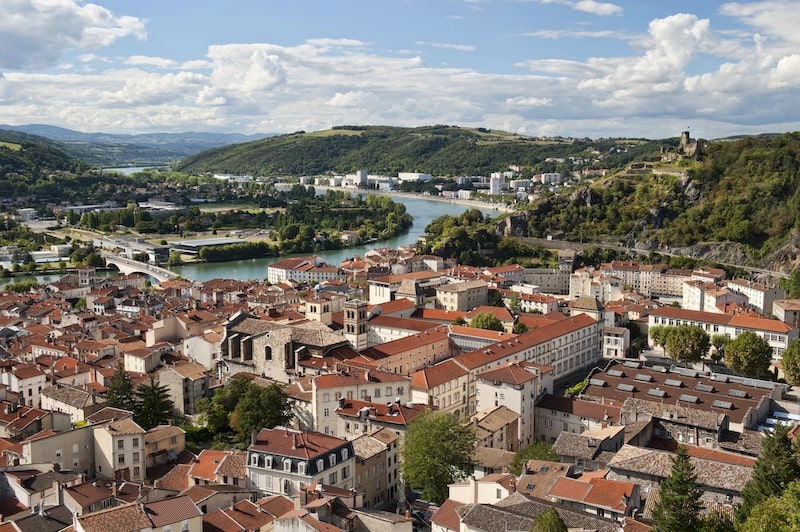
At first glance, Vienne seems unassuming, a quiet riverside town often bypassed by travelers bound for Lyon or Provence.
Yet appearances deceive.
This is a city with one of France’s richest mixes of history, from its vast 12,000-seat Roman theater to the medieval cathedral that hosted the historic papal council that dissolved the Knights Templar.
Add to this one of France’s largest weekly markets, a celebrated jazz festival and a water's edge setting framed by hills, and Vienne jumps out as anything but ordinary.
NOTE: Pages on this site may contain affiliate links, which support this site. See full Privacy Policy here.
Things to do and see in Vienne, France
Vienne is a patchwork of eras, in which medieval houses rub shoulders with Renaissance façades, and the occasional modern building peeks through between them.
Here, then, is a closer look at these various layers and at the culture and history Vienne has to offer.
Roman Vienne
One of Vienne’s major claims to fame lies in its Roman past – it boasts some of the best Roman ruins in France. The city once held 30,000 residents, making it one of the great provincial capitals of Gaul.
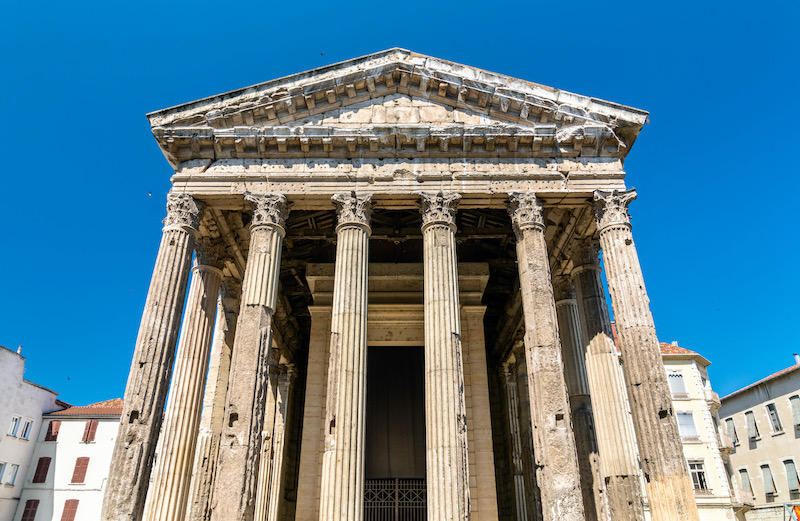 The famed Temple of Augustus and Livia
The famed Temple of Augustus and LiviaYou'll find plenty of Roman ruins here, of which these are the most famous:
- The temple of Augustus and Livia, which dates back to the first century CE.
- The Roman Theater, still used for its amazing acoustics today.
- The Garden of Cybele, a small archeological park below the theater with significant Roman ruins.
- Saint-Romain-en-Gal, home of an ancient Roman town and today the site of a stunning Gallo-Roman museum and mosaic restoration workshop.
- The Vienne Pyramid, a 15-meter stone obelisk on Place Fernand-Point, once the marker of the Roman circus, unique in France for its “Egyptian-style” form.
Here's an overview of Vienne's Roman heritage and a closer look at its sites.
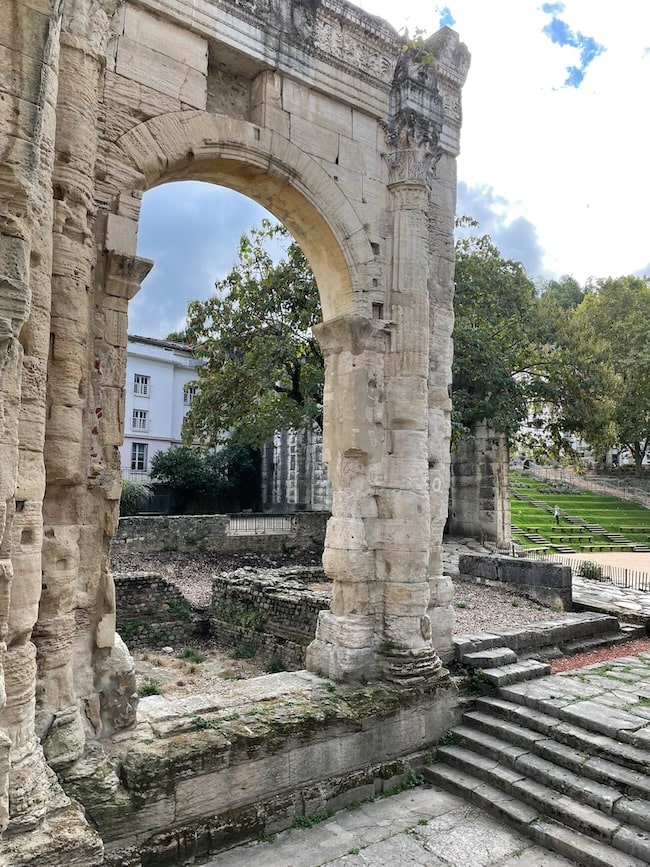 Jardin de Cybèle - stop here and look for Roman ruins on your way to the Roman theater ©OffbeatFrance
Jardin de Cybèle - stop here and look for Roman ruins on your way to the Roman theater ©OffbeatFrance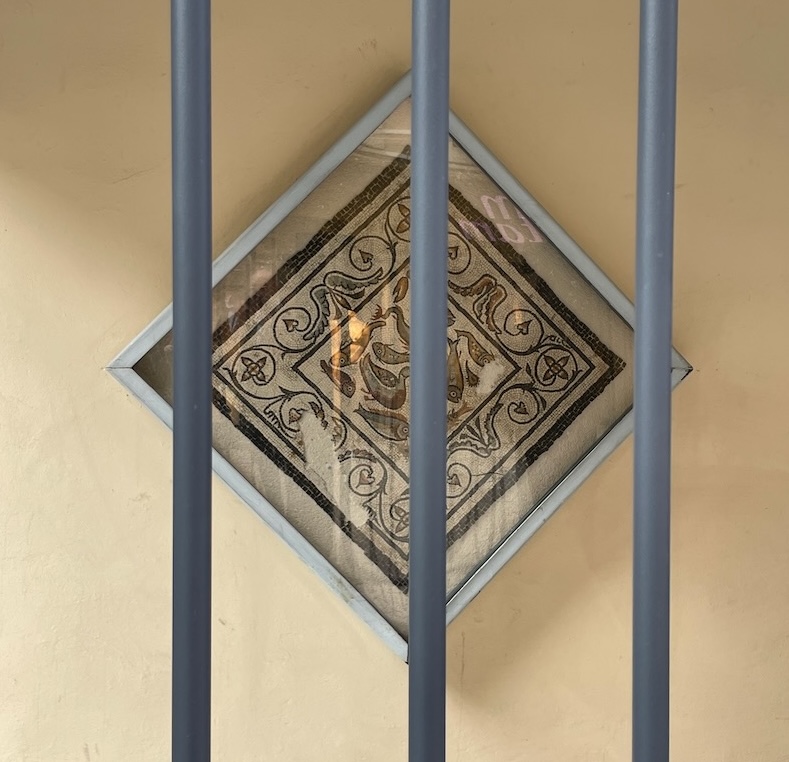 Construction works often uncover Roman mosaics, some of which remain where they are found, set into modern walls ©OffbeatFrance
Construction works often uncover Roman mosaics, some of which remain where they are found, set into modern walls ©OffbeatFranceVienne’s medieval churches and cloisters
While many people visit the city for its Roman artefacts, Vienne also played an unexpected role in papal history during the Middle Ages.
It was here, in the early 12th century in Saint-Maurice Cathedral, that Archbishop Guy of Burgundy was elected pope, taking the name Calixtus II, under which he would later broker peace between the Church and Europe's rulers. He also happens to have been the first pope to officially support and legitimize the recently created Knights Templar.
Two centuries later, another pope, Clement V, would choose the same cathedral to host the Council of Vienne, which would dissolve the order of the Templars, a case of coming full circle.
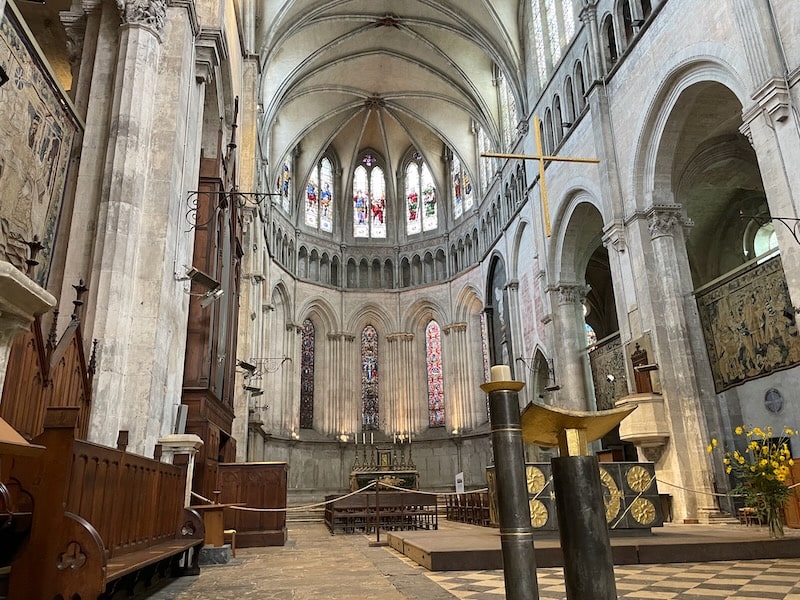
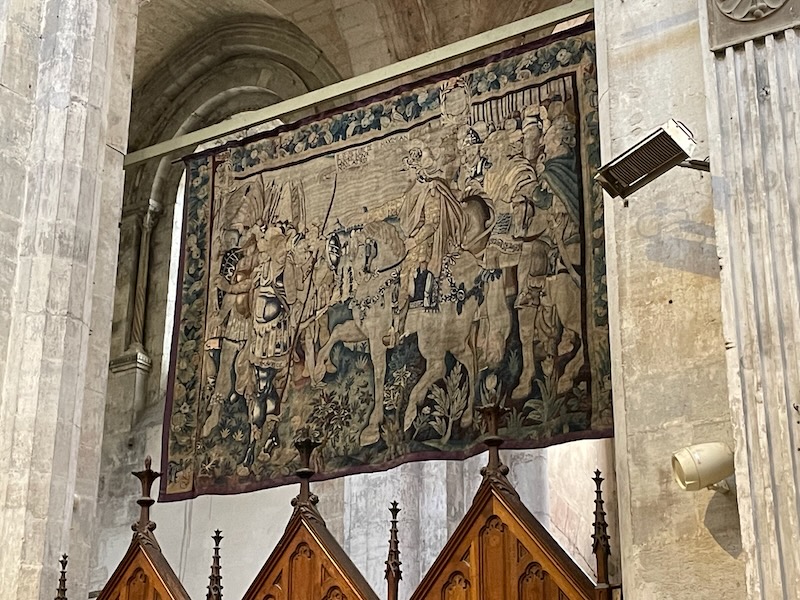 Interior of Saint-Maurice Cathedral, including one of several valuable medieval tapestries ©OffbeatFrance
Interior of Saint-Maurice Cathedral, including one of several valuable medieval tapestries ©OffbeatFranceSaint-Maurice Cathedral dominates the town center with its solid Gothic lines. Much of the stained glass on its side windowsis modern, a legacy of World War II bombings that destroyed several bridges and nearby quarters.
But take a moment and look up at the nave – you can almost hear the muted echoes of clerics debating the fate of the Templars in Latin.
Nearby, the small Romanesque church of Saint-André-le-Bas contains one of the few surviving 12th-century cloisters in France. It escaped destruction thanks to an unusual twist: in the 18th century it was converted into housing for worker in the textile industry, which ensured its survival until its 20th century restoration.
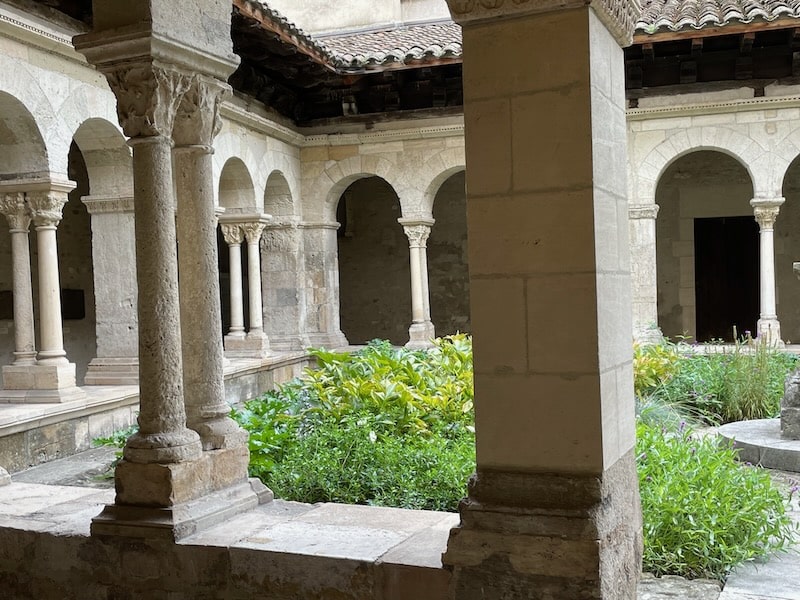 The cloister at Saint-André-le-Bas, one of the last remaining from the 12th century ©OffbeatFrance
The cloister at Saint-André-le-Bas, one of the last remaining from the 12th century ©OffbeatFranceSaint-Pierre church, one of the oldest in France, until recently housed a lapidary museum filled with Roman stones, sarcophagi and carvings.
The collection was started in the 18th century and continued to grow.
So extraordinary was it that the decision was made to turn the church into a museum of history, to be opened in the next few years.
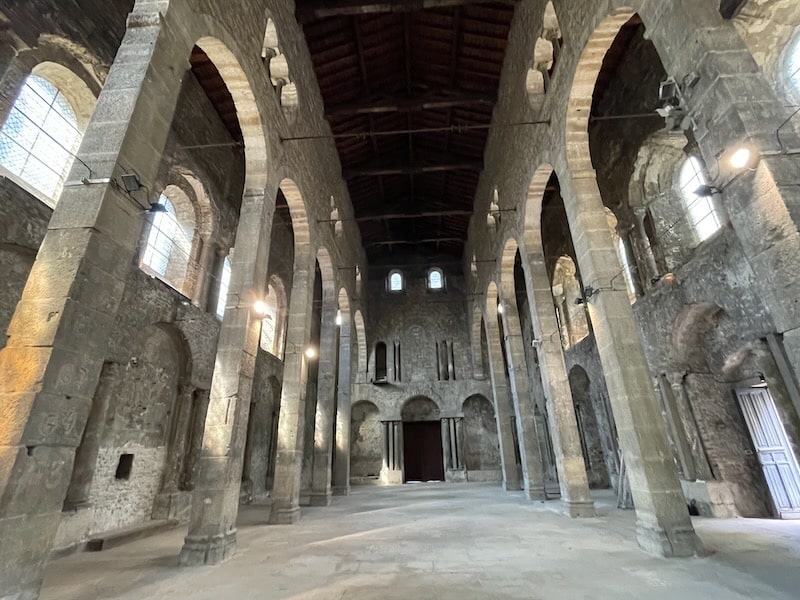 The interior of the museum-church is now bare but it's not too hard to imagine what it might have looked like - and what it will look like in future ©OffbeatFrance
The interior of the museum-church is now bare but it's not too hard to imagine what it might have looked like - and what it will look like in future ©OffbeatFranceJulie Chevailler, who leads the museum project, says it is a massive undertaking: "We had to empty the church of all its contents, and some of the stones and columns weighed tons. And we won't be using any additional public spaces – the church itself will be an integral part of the museum."
The Vienne Heritage Trail
The city's historic core is compact and easy to explore.
Follow the official balade dans le centre historique, (stroll in the historic center) by getting a map from the tourist office (mine is a blurred photo!) or looking for the round bronze plaques embedded in the sidewalk.
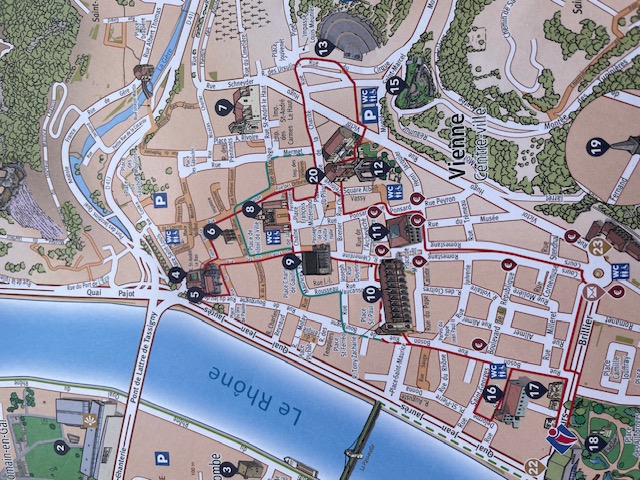
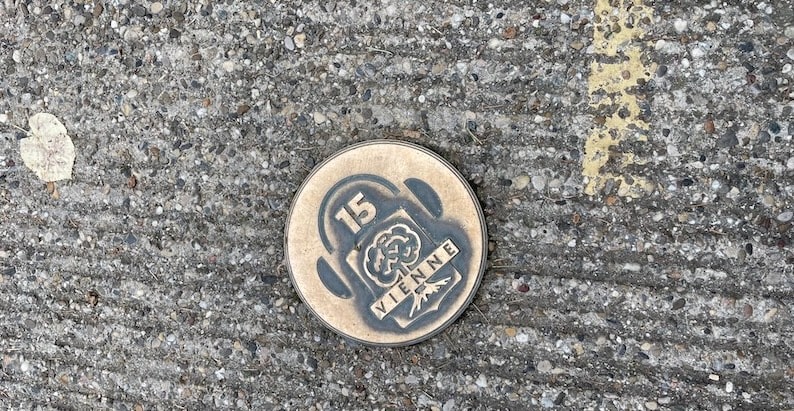 These are the numbered bronze buttons you should follow along the street... ©OffbeatFrance
These are the numbered bronze buttons you should follow along the street... ©OffbeatFranceHere are just a few of the highlights:
- Maison du Pilori – the only surviving timber-framed house in Vienne (15th century), with its distinctive overhanging upper floors.
- Place du Pilori – dotted with Roman fragments and medieval façades (this is where miscreants were pilloried, their head and hands placed
- Jardin du 8 mai 1945 – where a stretch of Roman road and a 4th-century milestone have been preserved, along with an enigmatic stone lion once thought to have come from Rome “by miracle.”
- Belvédère de Pipet – the best view in town, overlooking the Rhône valley, the Roman theatre, and the Pilat Mountains, with the chapel of Notre-Dame-de-la-Salette at the summit
- Château de la Bâtie – perched above the Rhône, this 13th-century fortress was built by Archbishop Jean de Bernin and later hosted Pope Clement V during the Council of Vienne. The site is closed to visitors but easily visible from the belvédère.
TIP FOR THE ROUTE
Climb the Belvédère de Pipet for the best panorama over the theatre, the Rhône and the old town. The 19th-century chapel of Notre-Dame-de-la-Salette crowns the hill.
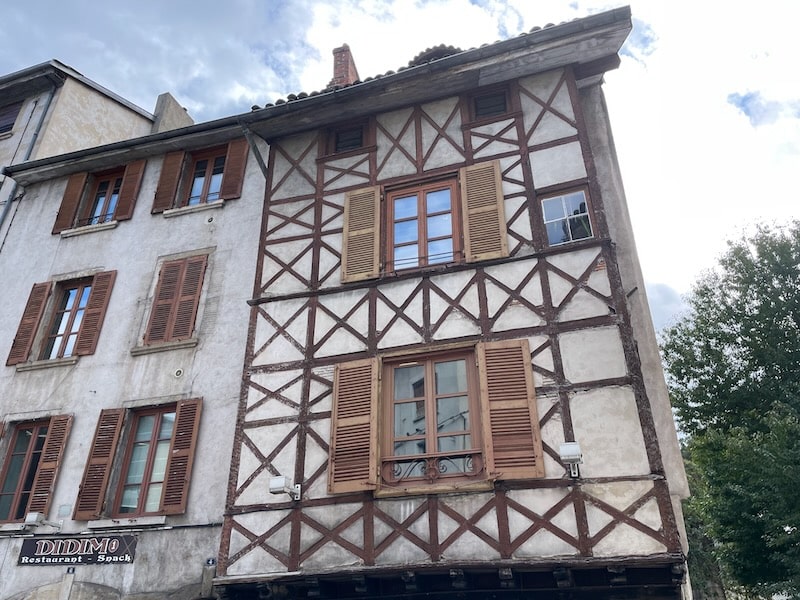 One of Vienne's oldest (non-Roman) buildings ©OffbeatFrance
One of Vienne's oldest (non-Roman) buildings ©OffbeatFrance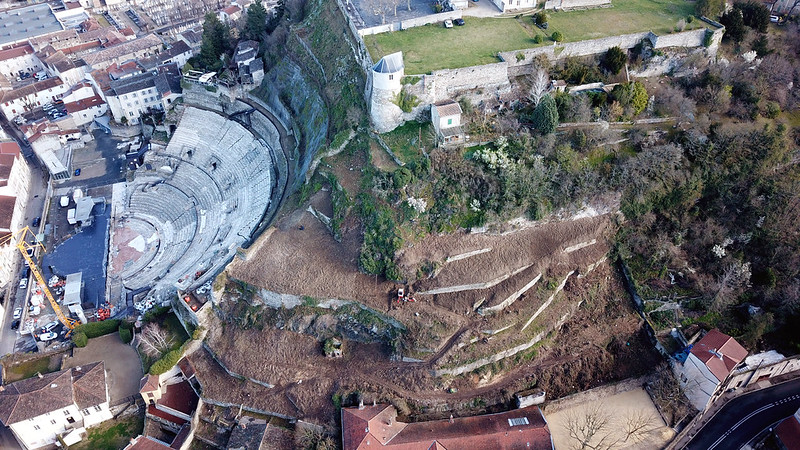 Aerial view of Mt Pipet and the Roman theater below ©S.Ogier
Aerial view of Mt Pipet and the Roman theater below ©S.OgierThe Saturday market
On Saturdays, Vienne holds one of France’s largest weekly markets. Some say it’s France's second-largest, although the Breton city of Rennes competes for that same title.
Still, locals here will insist theirs is the best. Endless stalls stretch along the streets, overflowing with seasonal produce, cheese, charcuterie, and local specialties.
It isn’t just about shopping – it’s about atmosphere. This is where the city gathers, where small producers sell directly, and where you can wander with no particular goal, nibbling, sampling, and people-watching.
Alongside food stalls, you’ll find local crafts, flowers, and clothing, and in December, the same streets host a lively Christmas market.
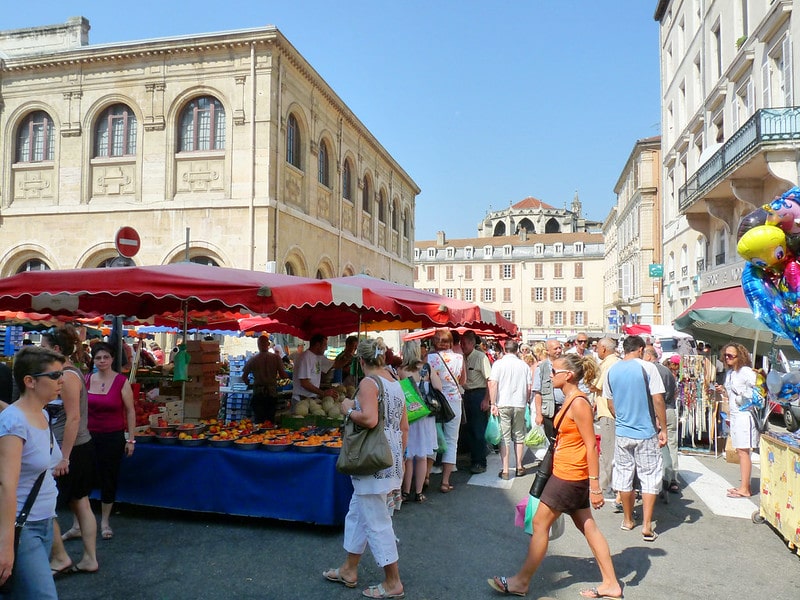
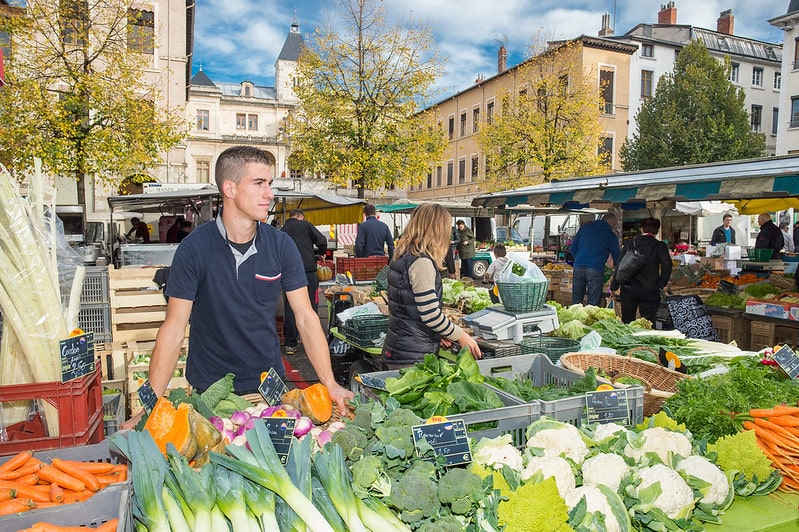 Views of the Saturday market in Vienne France - probably France's second largest. Top: ©Nicolas Combe. Bottom: ©GAEC-primeurs-ampuis
Views of the Saturday market in Vienne France - probably France's second largest. Top: ©Nicolas Combe. Bottom: ©GAEC-primeurs-ampuisJazz à Vienne
One of Vienne's most famous accomplishments is the Jazz à Vienne festival, launched in 1981.
The festival transforms Vienne into a music city, drawing around 230,000 people over three weeks to what has become one of Europe’s biggest jazz events.
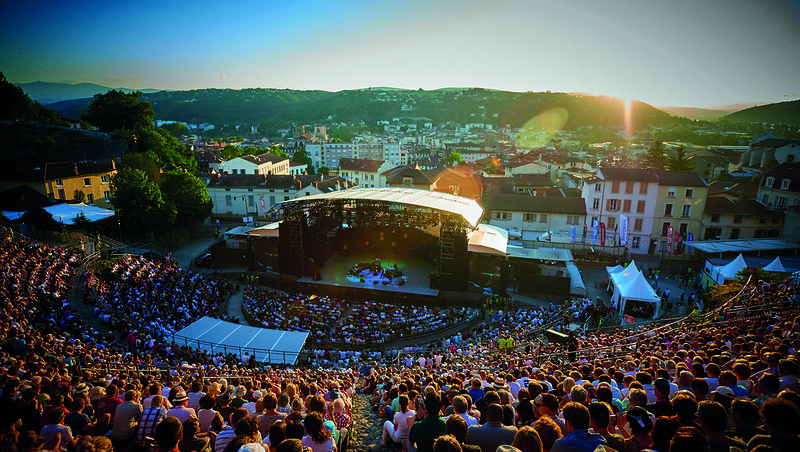 The Jazz Festival in Vienne is now one of Europe's largest ©Sylvain Madelon
The Jazz Festival in Vienne is now one of Europe's largest ©Sylvain MadelonThe main event is held at the spectacular Roman theater, a first-century structure seating about 12,000, but music spills everywhere: churches, squares, even the temple of Augustus and Livia. The entire town takes part, and locals suggest that you book accommodation months ahead because during the festival, the city overflows.
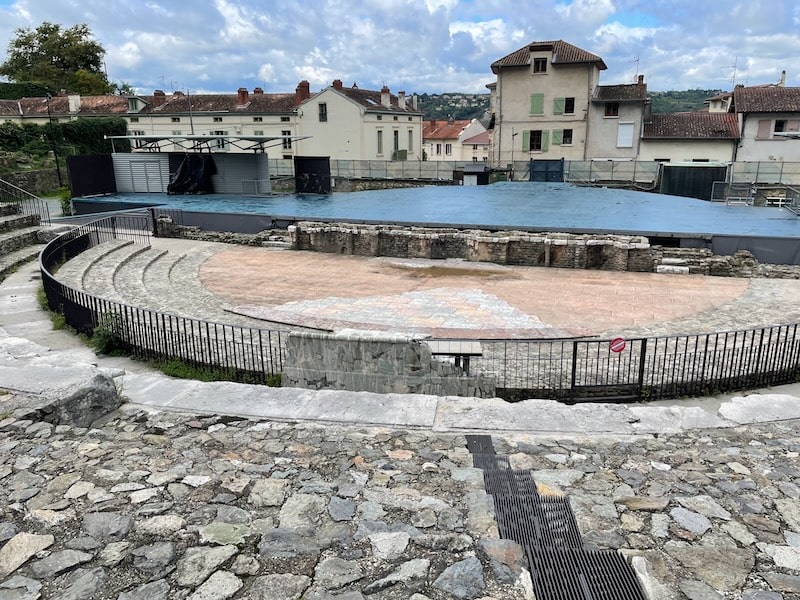
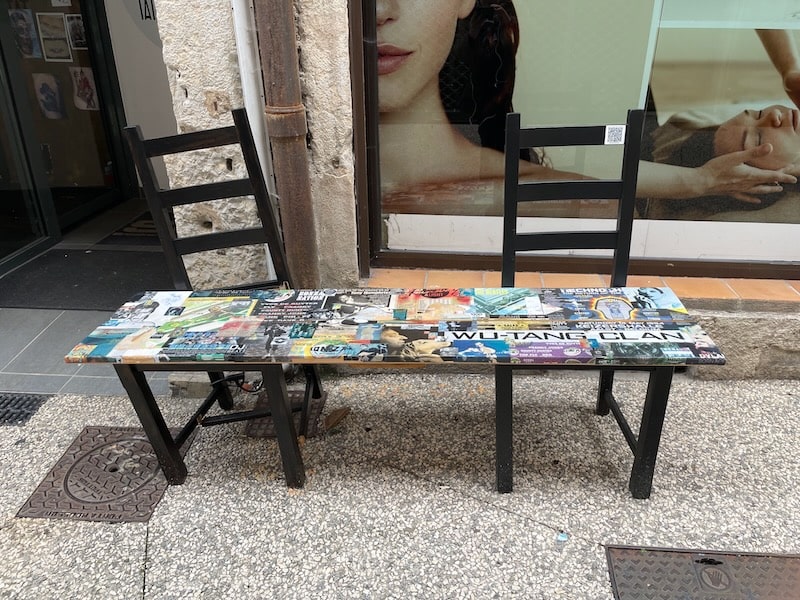 Top: main jazz venue, the Roman theater. Bottom: Across the city you'll find colorful wooden benches, each with individual designs. They were painted and placed by residents as part of a community project tied to the jazz festival, and they are now a permanent fixture ©OffbeatFrance
Top: main jazz venue, the Roman theater. Bottom: Across the city you'll find colorful wooden benches, each with individual designs. They were painted and placed by residents as part of a community project tied to the jazz festival, and they are now a permanent fixture ©OffbeatFranceCulture and modern life
Vienne’s cultural life extends beyond its monuments.
In early September, the Vienne Historique festival re-creates a medieval fair with markets, parades, and performances in the Roman theatre.
The Halle des Bouchers stages contemporary art exhibitions, while the Street Art Urbain festival each summer turns the Estressin district into an open-air gallery.
If you prefer galleries to ruins, the Musée des Beaux-Arts et d’Archéologie (in the former grain hall) pulls Roman, medieval and 19th-century Vienne together under one roof.
Small independent shops keep traditional crafts alive — Poterie Dubernard for ceramics, Orijjine for zero-waste goods, and Mr Coco for creative chocolates.
The Vienne-Condrieu Wine Route
Vienne marks the northern gateway to the Côtes du Rhône, whose terraced vineyards — first carved in Roman times — are now the subject of a UNESCO World Heritage nomination for its two millennia of continuous viticulture.
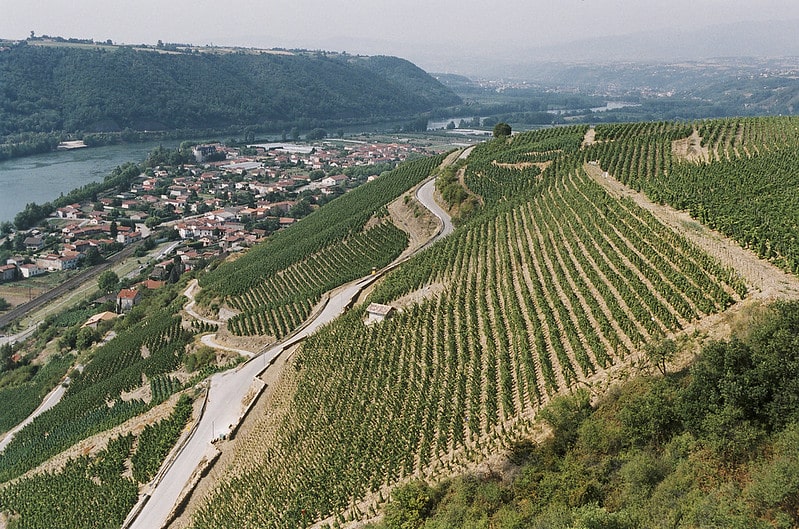 A glorious aerial view of one of Vienne's vineyards, Domaine La Varia, Côte-Rôtie ©E.GUIGAL SAS / Stéphane Chalaye Photographie
A glorious aerial view of one of Vienne's vineyards, Domaine La Varia, Côte-Rôtie ©E.GUIGAL SAS / Stéphane Chalaye PhotographieThe Vienne-Condrieu Wine Route offers wine lovers tastings and visits across 30 estates between Vienne, Ampuis and Condrieu. Many cellars open by appointment for small-group tastings, often led by the winemakers themselves.
Try E. Guigal and Vignobles Pichat in Ampuis, Vignobles Verzier Chante-Perdrix in Chavanay, and for wines from across the northern Rhône, there's the Maison des Vins de Vienne.
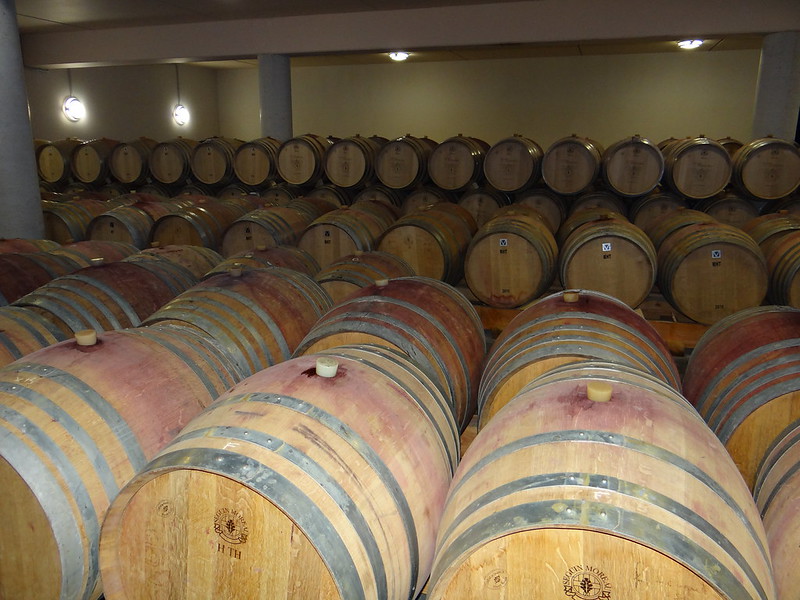 Barrels in the Domaine Christophe Semaska, one of many excellent Vienne wineries ©DR
Barrels in the Domaine Christophe Semaska, one of many excellent Vienne wineries ©DROf course there are a number of festivals related to wine. These annual events deserve a visit if you're in town while they're taking place:
- Vinalia Festival (late September): a two-day event at Saint-Romain-en-Gal celebrating Roman food and wine traditions with demonstrations, tastings, and re-enactments.
- Marché aux Vins d’Ampuis (January) — a prestigious wine fair that draws top Rhône producers and international buyers.
- Jazz and Wine evenings (July) — Jazz à Vienne partners with local wineries.
Taste something unique: the Triumph pear
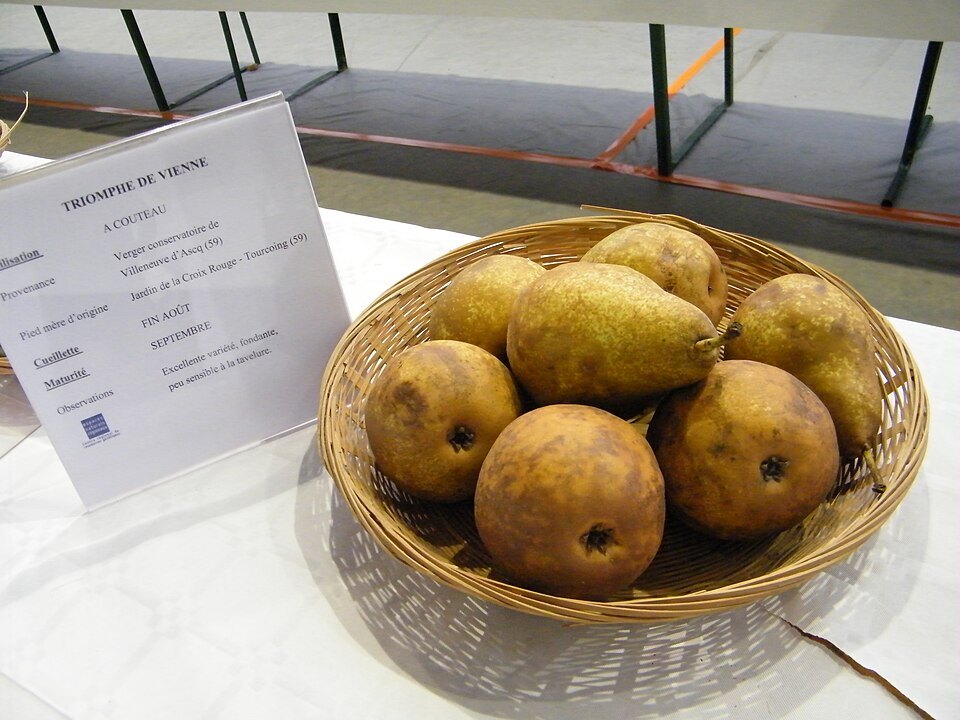 A basket of triumph pears. Photo ©APictche via CC BY-SA 4.0
A basket of triumph pears. Photo ©APictche via CC BY-SA 4.0Here's something you won't find anywhere else...
In the 19th century, the Triumph pear was Vienne’s pride. Sweet, delicate, and widely grown, it vanished when hardier varieties like the Williams pear took over. By the 20th century the Triumph was thought lost.
Then, in 2010, the city sought to revive it. Cuttings preserved in Japan were brought back, grafted, and replanted.
Today, the Triumph pear is once again grown around Vienne. Most of the crop goes into juice, jams and fruit pastes. You’ll find it in shops and at the market — a rare taste of a fruit rescued from extinction. You can also pick up some pear-based products at the tourist office.
Practical tips about Vienne, France
When to go: Vienne is lively year-round, but the jazz festival (July) and market days (Saturdays) are especially vibrant.
How long to stay: A single day from Lyon is enough to see the highlights, but stay overnight if you want to enjoy a festival or explore at a slower pace. And if you can squeeze in a Saturday, you'll have the market!
Getting there: Trains from Lyon take just 20 minutes, making Vienne one of the easiest day trips in the Rhône Valley.
Eating in Vienne: The city is peppered with restaurants, and two places I enjoyed were La Brasserie d'Alice across from the train station and Ô Bievva in the Old Town.
Where to stay: For a 16th-century property with Rhône views, stay at La Bâtie; if you'd rather stay in the Old Town, there are plenty of apartments, like this super central private studio in the Old Town.
FAQ
Is Vienne worth visiting?
Is Vienne worth visiting?
How far is Vienne from Lyon?
How far is Vienne from Lyon?
When is the Jazz à Vienne festival?
When is the Jazz à Vienne festival?
From end June to mid-July, usually lasting three weeks.
Before you go...
Vienne may not have the fame of Lyon or Avignon, but that’s part of its appeal. Where else can you walk from a Roman theater to a medieval cloister, sip pear juice from a fruit once thought extinct, and end your evening with jazz in a 2,000-year-old monument?
This little city on the Rhône has always lived in the shadow of bigger neighbors, which is why for travelers, it is always a surprise.
–Header image courtesy ©Vienne Condrieu Tourisme/JFM
Did you enjoy this article? I'd love if you shared it!

